Comprehensive Guide to Smart Oven Convection Technology
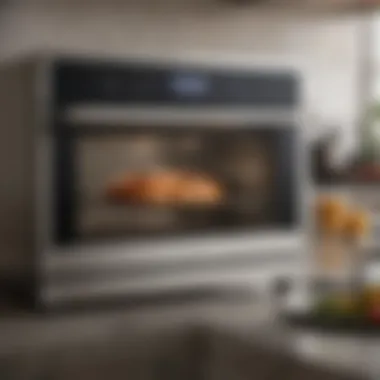
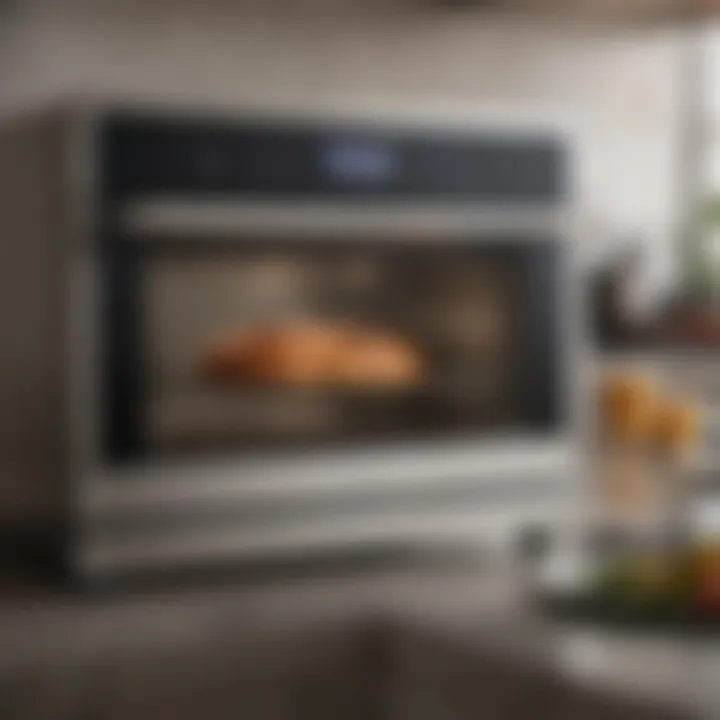
Intro
Smart oven compact convection technology represents a significant leap in culinary capability, merging modern innovation with age-old cooking principles. This technology operates by circulating heated air around the food, which leads to even cooking and reduced preparation times. It is refreshing to explore how this development can alter our approach to cooking, making it not only faster but also providing various methods to prepare a diverse array of dishes efficiently.
Understanding smart ovens and their functionalities is crucial for any food lover. Such ovens often combine several cooking methods into one unit, including baking, broiling, and roasting. The integration of smart features like connectivity and programmable settings give users more control over their cooking. The implications of this technology extend beyond mere convenience; it has the potential to enhance the quality of the food cooked and make the cooking process more enjoyable.
In this article, we will cover various aspects of smart oven compact convection technology. From the fundamentals of how convection cooking works to the benefits it offers over traditional cooking methods, we will provide a thorough understanding. Additionally, we will discuss practical applications and considerations for users as they integrate this technology into their kitchens.
"Smart ovens represent not just a shift in cooking methods but also a new perspective on our culinary interactions."
Now, let us delve into the features that define smart oven compact convection technology.
Understanding Smart Ovens
Smart ovens represent a significant shift in culinary technology, blending traditional cooking methods with advanced features designed to enhance both usability and efficiency. In this section, we elaborate on what defines smart ovens, their essential features, and how understanding these elements can inform your purchasing decisions and cooking practices.
Definition and Features
A smart oven is an appliance that integrates connectivity and automation into the cooking process. These ovens can often be controlled remotely through smartphones or tablets, allowing you to preheat, adjust cooking times, and even receive notifications when your meals are ready. Key features of smart ovens typically include:
- Wi-Fi Connectivity: Enables remote operation and monitoring.
- Touchscreen Interfaces: Provide intuitive access to various cooking modes and settings.
- Voice Control Compatibility: Some smart ovens support voice assistants like Amazon Alexa or Google Assistant, enhancing convenience.
- Remote Cooking Programs: Users can set specific cooking programs and control them from a distance.
Understanding these features helps you appreciate the versatility that smart ovens offer, catering to diverse culinary needs and modern lifestyles.
How Smart Ovens Work
Smart ovens operate on principles distinct from traditional ovens, primarily through the use of technology that enhances cooking precision and timing. Here’s an overview of how they function:
- Sensors and Monitoring: Smart ovens include sensors that optimize cooking by adjusting temperatures and timings based on the food being prepared. This can significantly reduce the chances of overcooking or undercooking.
- Digital Controls: Rather than relying solely on physical knobs, smart ovens often utilize digital interfaces that provide visual feedback and precision input. This can simplify the cooking process, making it intuitive.
- App Integration: Many models come equipped with an accompanying app that allows users to control the oven remotely. The app may also provide recipes and suggested cooking settings based on the ingredients you have.
In summary, smart ovens combine heating elements with technology to facilitate more accurate and efficient cooking, making them a valuable addition to any kitchen.
Compact Convection Technology Explained
Compact convection technology represents a significant advancement in culinary arts. It combines the principles of convection cooking with the convenience of compact appliances. This technology has gained traction among modern kitchens for its efficiency and effectiveness. Understanding it is essential for anyone looking to enhance their cooking experience.
Principles of Convection Cooking
Convection cooking leverages a fan to circulate hot air within the oven. This method ensures uniform heat distribution. Therefore, food cooks more evenly compared to traditional methods. The fan decreases cooking time and can produce crispier textures.
Key principles include:
- Hot Air Circulation: The fan moves air around the food, eliminating cold spots.
- Even Cooking: Ensuring all sides of the dish receive consistent heat.
- Higher Cooking Efficiency: Cooking can occur at lower temperatures than with conventional ovens.
This technique allows for a variety of culinary techniques like baking, roasting, and broiling, offering versatility to users.
Advantages of Compact Designs
Compact convection ovens are designed to save space while maximizing functionality. Their size does not limit their capabilities; instead, it enhances daily kitchen routines.
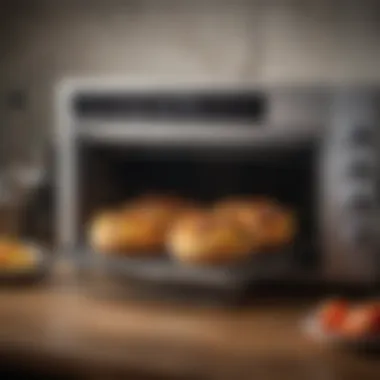

Benefits include:
- Space-Saving: Ideal for smaller kitchens or apartments, they occupy less counter space.
- Energy Efficient: Using less energy compared to larger ovens leads to reduced utility costs.
- Faster Cooking Time: The compact size generally allows for quicker heat-up and cooking times.
- User Friendly: Simplified controls often make these ovens accessible to a broad audience, even those less familiar with cooking technologies.
In summary, compact convection technology presents a modern solution that balances functionality with convenience. It is tailored for the evolving needs of cooking enthusiasts. Understanding these elements can help users capitalize on the benefits of this technology in their kitchens.
Benefits of Smart Oven Compact Convection
Smart ovens that incorporate compact convection technology provide several distinct advantages in the kitchen. By understanding these benefits, users can optimize their cooking processes and enhance the quality of their culinary creations. This section addresses three significant aspects: energy efficiency, time-saving features, and enhanced cooking precision. Each of these elements contributes to a seamless cooking experience, making smart ovens a valuable addition to modern kitchens.
Energy Efficiency
Energy efficiency is a paramount consideration for many consumers today. Smart oven compact convection models are designed with this in mind. They utilize less energy compared to traditional ovens, thanks to their innovative convection technology. The fans within the unit circulate hot air evenly throughout the cooking chamber. This leads to quicker cooking times and ensures that food cooks evenly.
Moreover, many modern smart ovens have energy-saving modes that adjust settings based on the food being cooked. For instance, users can engage eco-friendly options, which reduce power consumption when the oven is not in active use. Operating a smart oven efficiently not only lowers utility bills but also fosters a more sustainable cooking approach. By choosing energy-efficient appliances, consumers are playing a part in reducing their ecological footprint.
Time-Saving Features
Time is a critical element in cooking, particularly in today’s fast-paced lifestyle. Smart ovens equipped with compact convection technology offer several time-saving features that appeal to busy individuals. For instance, preheating times are significantly reduced. In many cases, the oven reaches the desired temperature faster than conventional models which can take long minutes. This means it is possible to start cooking almost immediately after preparation.
Additionally, many smart ovens come with programming capabilities. They allow users to set precise cooking times and temperatures for various dishes automatically. This hands-free functionality means users can attend to other tasks while the oven cooks, enhancing overall productivity in the kitchen.
"Time-saving features in smart ovens enable users to maximize their cooking potential without being tethered to the kitchen."
Enhanced Cooking Precision
Precision is another hallmark feature of smart ovens with compact convection technology. The ability to control temperature and time with greater accuracy leads to improved cooking outcomes. These smart ovens often come with integrated probes that allow for real-time monitoring of food temperatures. This ensures that meat is cooked to the ideal doneness, thereby reducing the risk of overcooking.
Furthermore, many models have modes specifically designed for different cooking techniques, such as baking, broiling, or roasting. This versatility allows users to experiment with various cooking methodologies and achieve gourmet results. The intelligent adjustment of settings based on recipe requirements ensures that users obtain reliable results each time they cook. Having this level of control means less guesswork and enhances the joy of preparing meals.
In summary, smart oven compact convection technology emphasizes energy efficiency, saves valuable time, and enhances cooking precision. For anyone who values quality and efficiency in the kitchen, these systems represent an intelligent investment.
Features to Look For
Understanding the features of smart ovens is crucial for making an informed decision when choosing the right appliance for your kitchen. With various options available, certain elements stand out, driving the choice of buyers and enhancing the cooking experience. Here are some key features that should not be overlooked.
Smart Connectivity Options
Smart connectivity has become a defining characteristic of modern kitchen appliances. Smart ovens often connect to Wi-Fi or Bluetooth, allowing users to control the oven remotely or integrate it with other smart devices in the kitchen. This connectivity enables functions such as:
- Remote monitoring and control: Users can preheat their oven from anywhere, ensuring that it is ready when they arrive home.
- Integration with smart home systems: Compatibility with systems like Amazon Alexa or Google Assistant enables voice control.
- Cooking guidance and recipes: Many smart ovens come equipped with apps that suggest cooking time or temperature based on the selected dish. This feature minimizes guesswork and maximizes cooking accuracy.
User Interface and Controls
An intuitive user interface can dramatically enhance the experience of using a smart oven. Modern devices often incorporate touch screens or smartphone apps that simplify operation. Key considerations include:
- Ease of navigation: Controls should be simple to understand, allowing users to adjust settings quickly and efficiently.
- Custom programmability: The ability to save favorite cooking settings can save time and ensure consistency across multiple uses.
- Feedback mechanisms: Visual or auditory signals indicating completion of a task provide essential awareness of cooking status.
Safety Features
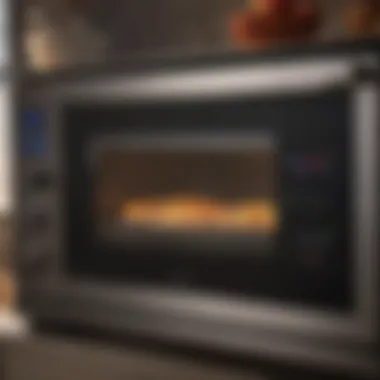
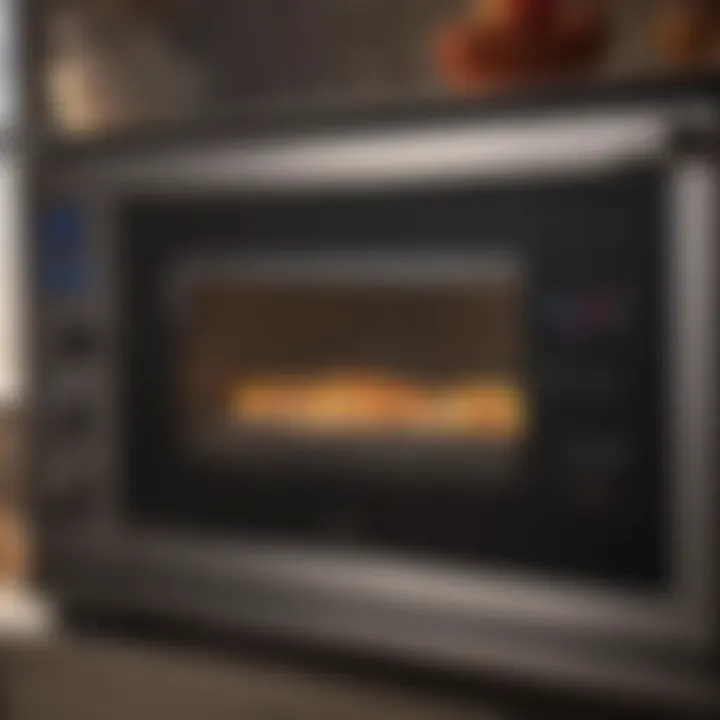
Safety should be a priority in any kitchen appliance, especially in devices that use high heat. Smart ovens often include a range of safety features designed to protect users:
- Auto shut-off: Many smart ovens will automatically turn off after a set time if not used, preventing potential hazards.
- Child lock features: To prevent accidents, many models include options to lock the controls, providing added security in homes with children.
- Heat resistant materials: Robust construction materials enhance safety by reducing the risk of burns or fires.
"When investing in kitchen technology, it is crucial to prioritize features that enhance safety and usability."
By considering these features in smart ovens, users can ensure they select a model that not only meets their cooking needs but also enriches their overall culinary experience.
User Considerations
Understanding user considerations is critical when adopting smart oven compact convection technology. This segment aims to address significant factors that potential users should keep in mind. Ensuring compatibility with your kitchen space, evaluating budget implications, and gauging user experience and feedback are essential to make an informed decision. By focusing on these aspects, you can enhance the practicality of your cooking experience and the overall satisfaction with your appliance.
Kitchen Space and Setup
One of the primary factors to consider is the available kitchen space. Smart ovens come in various sizes and designs. Measuring your kitchen dimensions is essential to determine the appropriate fit for the appliance. This avoids issues such as cramped spaces or ineffective workflows.
Think about:
- Countertop Space: Ensure you have adequate space to accommodate the oven without obstructing other kitchen elements.
- Ventilation Needs: Some models may require specific ventilation setups, affecting where you can place the oven.
- Access to Power Outlets: The location of power sources can dictate placement.
Additionally, the layout of your kitchen can enhance or hinder cooking efficiency. Positioning the smart oven wisely can facilitate better workflow, making meal preparation more enjoyable.
Budget and Investment Worthiness
When contemplating a smart oven, understanding your budget is vital. Initial costs for these ovens can be higher than traditional models. However, the features and efficiencies gained often justify the expense over time.
Consider evaluating:
- Long-term Savings: Smart ovens can save energy and reduce cooking times. This may translate into lower utility bills.
- Warranty and Support: Some brands offer excellent customer service and extended warranties, which can add value.
- Resale Value: If you plan to upgrade in the future, high-quality smart ovens may hold resale value better than less advanced appliances.
It's crucial to balance upfront costs with long-term benefits when deciding on a smart oven.
User Experience and Feedback
User experience is often a deciding factor in choosing a smart oven. Insights from current users can provide valuable information about the appliance's performance and reliability.
Important aspects to investigate include:
- Ease of Use: Many smart ovens integrate with mobile applications, which can facilitate remote operation and programming. User reviews can highlight any challenges in understanding these technologies.
- Cooking Performance: Feedback regarding cooking accuracy, evenness, and speed can inform your decision.
- Maintenance Needs: User experiences regarding the maintenance and cleaning of the appliance can impact satisfaction in the long run.
Investigating user reviews on platforms such as Reddit and user ratings on sites like Britannica can aid in gathering informed perspectives.
Practical Applications
The practical applications of smart oven compact convection technology are significant. Understanding these applications allows users to make informed decisions, maximizing the utility of their investment. Smart ovens offer flexibility and efficiency for a range of cooking scenarios. From daily meals to festive gatherings, how one utilizes these appliances can greatly influence the overall cooking experience and outcomes.
Everyday Cooking Scenarios
In everyday cooking, smart oven compact convection technology stands out for its versatility. Users can prepare a variety of dishes with ease. For example, reheating leftovers becomes more efficient due to the convection fan, which circulates heat evenly. Unlike traditional ovens, where hot spots may occur, compact convection ensures consistent warmth. This results in better texture and flavor retention, enhancing even simple meals.


Additionally, these ovens can tackle meal prep tasks such as baking, roasting, and broiling all in one device. A busy individual might use a smart oven to bake a chicken while simultaneously roasting vegetables. This dual capability saves time and energy, which is especially beneficial for those with limited cooking experiences or time constraints.
Moreover, smart ovens often include pre-set cooking options. These features guide new cooks through the process with suggested temperatures and times. This helps eliminate guesswork and encourages home-cooked meals. Accessibility is a key point; meal preparation becomes less intimidating with the right technology in place.
Special Occasion Cooking
When it comes to special occasion cooking, smart ovens excel by allowing users to impress guests with their culinary skills. The compact convection technology provides a level of precision that can elevate any dish. For instance, baking a delicate soufflé requires controlled temperatures and even cooking processes. With smart ovens, the user can rely on precise settings to achieve the desired results.
This technology also facilitates cooking for larger gatherings. Users can prepare multiple dishes simultaneously, thanks to the consistent heat distribution. This capability is particularly useful during holidays or celebrations when time is of the essence. Imagine cooking a ham, sides, and desserts all in your smart oven a short time apart.
Furthermore, many smart ovens offer remote monitoring via apps, allowing users to check cooking progress without being physically present. This adds a layer of convenience. For example, a host can focus on greeting guests while the oven takes care of the cooking.
Comparison with Traditional Ovens
Understanding the differences between smart oven compact convection technology and traditional ovens is essential in today’s culinary landscape. As home cooking continues to evolve, it is vital to evaluate how these two cooking methods measure up against one another. This comparison sheds light on various critical aspects, particularly concerning cooking efficiency and culinary versatility. Knowing these differences allows users to make informed decisions that can enhance their cooking experience.
Cooking Time Efficiency
Smart ovens significantly improve cooking time efficiency compared to traditional ovens. These modern appliances utilize convection technology, which circulates hot air around the food. Consequently, dishes cook faster and more evenly. A conventional oven often relies on static heat sources, which can lead to uneven cooking and longer preparation times.
For instance, when baking a cake, a smart oven can yield results in around 25% less time than a traditional oven. Moreover, the ability to set precise temperatures through smart connectivity can optimize the cooking process further. Here are some aspects of cooking time efficiency:
- Preheating: Smart ovens often preheat quicker than traditional models.
- Temperature Control: Advanced sensors ensure consistent temperatures, reducing the risk of overcooking.
- Cooking Programs: Many smart ovens come programmed with specific settings for various dishes, optimizing the time needed for desired results.
"The use of convection technology allows for not just quicker cooking times, but also better energy efficiency in smart ovens."
Versatility in Cooking Techniques
Smart oven compact convection technology excels in versatility, allowing users to experiment with various cooking techniques. Traditional ovens tend to be somewhat limited in functionality, often being used solely for baking, broiling, or roasting. In contrast, smart ovens offer numerous cooking options, making them suitable for a wider range of culinary preparations.
With a smart oven, users can:
- Bake with accurate temperature settings.
- Roast while maintaining moisture and ensuring an even cook.
- Air fry, achieving crispy textures without excessive oil.
- Dehydrate fruits, vegetables, or herbs for long-term storage.
- Reheat leftovers more effectively, preserving flavors and textures.
This versatility not only enhances meal options but also encourages creativity in the kitchen. Users can engage in various cooking methods, enhancing their culinary skills and experiences.
By evaluating these comparisons, it becomes clear that smart oven compact convection technology offers superior time efficiency and versatility. This knowledge is crucial for food lovers aiming to maximize the potential of their kitchen appliances.
Final Thoughts on Smart Oven Compact Convection
As we conclude our exploration of smart oven compact convection technology, it is important to reflect on its relevance and impact on contemporary cooking practices. The integration of technology into our kitchens symbolizes a shift towards innovation that enhances efficiency and precision in food preparation. Smart ovens are not merely fancy gadgets; they signify a profound transformation in how we approach cooking.
Integrating Technology into Cooking
The rise of smart ovens represents a significant leap in culinary technology. These devices allow users to utilize features like remote monitoring, pre-programmed cooking options, and precise temperature control. Integration with smartphone apps enables seamless management of cooking tasks, providing real-time updates on the cooking progress. Users can set timers and adjust settings from anywhere in their home, minimizing the time spent in the kitchen while maximizing control over their meals.
The ability to customize cooking experiences according to personal preferences is another critical aspect of smart ovens. With options to choose from cooking modes, such as baking, broiling, or toasting, the versatility enhances the culinary experience. This adaptability accommodates both novice and seasoned cooks, making the technology accessible to a broader audience.
Future Trends in Kitchen Appliances
The future of kitchen appliances is poised for even more innovation as smart technology evolves. We can anticipate the emergence of more integrated systems that communicate not just within the kitchen but with other home devices. For example, imagine optimizing cooking schedules based on the availability of meal ingredients in your refrigerator or connecting to meal planning services that suggest recipes based on pantry items. Such advancements will provide a personalized experience, making cooking more efficient and enjoyable.
Moreover, as sustainability becomes an important focus, manufacturers will likely invest in energy-efficient designs in smart ovens. This trend could lead to appliances that consume less power while offering superior performance. The development of new materials and technologies will further enhance cooking capabilities, inspiring more consumer interest.
"The ongoing evolution in kitchen technology isn't just about convenience; it’s about redefining how we engage with food preparation and culinary creativity."
In summary, smart oven compact convection technology is more than a cooking appliance; it is a centerpiece for innovation in the kitchen. By integrating technology into cooking, this innovation not only streamlines the cooking process but sets the stage for future advancements that will continue to enhance our culinary experiences.







